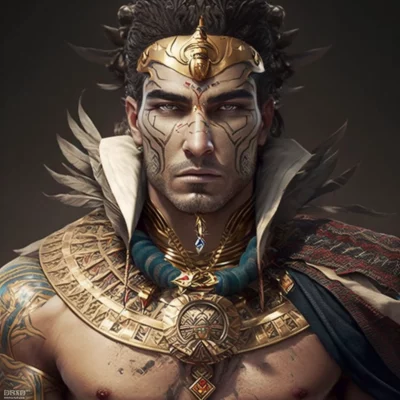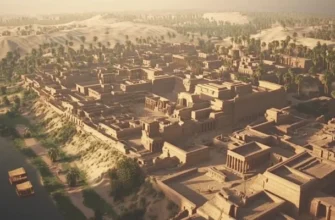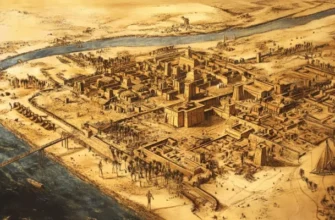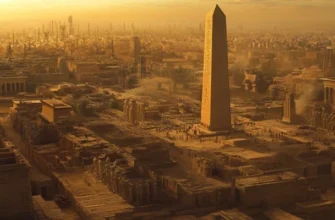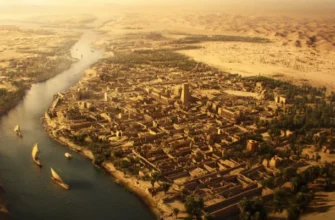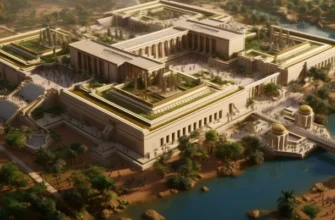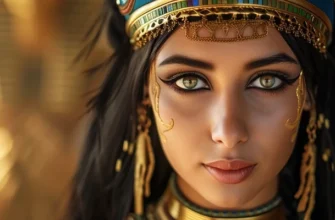Aker is an Egyptian god who symbolized the earth and mountains. In his depiction, he is represented as two lions holding the sun between them. The lions are usually depicted in a standing position, symbolizing the stability of the mountains, while the sun they hold symbolizes the light and warmth that spreads across the earth.
- Origin and history
- Appearance and symbolism
- Role and significance in Egyptian mythology
- Interaction with other gods
- Religious rites and practices
- Reflections of Aker in art
- Legends and stories about Aker
- Archaeological research and discoveries related to the god Aker
- Modern perception and use of the image of Aker
- Conclusion.
Origin and history
Aker is one of the many gods of Egyptian mythology. He was often associated with the earth and mountains, which symbolized stability and strength. He was also credited with a protective role in relation to the sun, which rose in the east and set in the west every day.
In ancient Egyptian mythology, the god Aker (sometimes known as Akeru) was recognized as the god who reigns over darkness and protects the sun ship Ra during its nighttime journey through the underworld.
Aker was depicted as a two-headed lion standing on two legs and supporting the heavens on his back. One head of the god faces east and the other west, reflecting his role in maintaining the balance between sun and darkness.
Other variants of Aker’s depiction include a two-headed bull or a two-headed human creature with lion’s paws. He was also depicted as a huge water snake that protected the entrances to the underworld.
Although Aker was not one of the most popular gods in Egyptian mythology, his importance lay in his role in preserving order in the underworld and protecting the sun during its journey westward. His cult may have been associated with funerary rites as well as magical practices to ensure safety and protection.
Appearance and symbolism
Aker was usually depicted as two lions standing on their hind legs and facing each other. He also often had a human face and was depicted with a beard and broad shoulders. His image in symbolism was accompanied by the image of the sun on the horizon.
Aker is an important god in Egyptian mythology who symbolized the earth and mountains, and also protected the sun’s rise. His images can be found in temples, pyramids, statues, and other artworks. His image has been used in modern art and design as a symbol of stability and strength.
Role and significance in Egyptian mythology
Aker was important in Egyptian mythology. He was considered the god of the earth and mountains, as well as the protector of the sunrise. His name translates as “that which stands on the earth”. His image could be found in temples and pyramids as the guardian of the entrance and protector of the earth.
Interaction with other gods
Aker played an important role in Egyptian mythology by interacting with other gods. For example, his image is often found alongside that of Ra, the sun god who appeared daily in the east and set in the west. Aker protected Ra from potential threats at sunrise and sunset, ensuring the sun’s safe passage from one part of the sky to another.
Religious rites and practices
In Egyptian religious rituals, Aker was used as a symbol of stability and strength. He was often depicted on the walls of temples, pyramids, and statues, symbolizing his knowledge and support. He was also associated with the idea of eternity, being as stable and unchanging as the earth and mountains he symbolized. Aker was revered and used as a protector, providing protection and security to his followers.
The god Aker played an important role in Egyptian mythology, interacting with other gods and symbolizing stability and strength. His role in religious rituals and practices was important to the Egyptian people, who considered him a protector. Aker’s symbolism continues to be used in contemporary art and design as a symbol of eternity and strength. Egyptian mythology has many gods and goddesses, each with their own unique role and symbolism. Aker, like many other gods, was an important element of Egyptian religion and culture that continues to generate fascination and interest among people to this day.
Reflections of Aker in art
Aker was often depicted on the walls of temples and pyramids along with other gods. His image could be found on some statues of pharaohs that were made of sandstone or granite. In artistic works, he was depicted as a large lion holding the sun between his paws.
In the art of Ancient Egypt, the god Aker was depicted on the walls of temples and pyramids along with other gods. He was depicted as a terrifying two-headed creature with the body of a lion, crocodile, or other animal. His two heads were placed on opposite sides, sometimes they had horns that symbolized strength. On the heads of Aker one could see symbols of water, sky, and earth.
In addition, Aker was depicted on walls and tiles in temples along with other gods such as Ra, Osiris, Isis, and others. He was also depicted in artworks such as statues and reliefs that depicted religious rites and myths.
In Egyptian art, Aker played an important role as a symbol of eternity and strength. He was recognized as a protector against evil spirits and protected people during the transition to the afterlife. His image has come to us from the walls of temples and pyramids, which testifies to his importance in Egyptian mythology and culture.
Legends and stories about Aker
One of the legends associated with Aker tells how he helped the sun return to heaven after its nightly journey to hell. According to the myth, after the death of the god Ra, he made his way to hell, where he passed through the 12 gates of darkness to be born again on earth with the rising of the sun. One day, on his way back to heaven, he met Aker, who carried him on his back across the Seret River. Since then, Aker has become the patron saint of the sun and is recognized as one of those who help the sun return to heaven.
Another legend is associated with the lecherous goddesses Isis and Nephthys. According to the myth, these two goddesses got lost in the desert while looking for husbands. They met Aker, who offered them protection and helped them find husbands. For his help, Aker became the patron saint of prostitutes and was often depicted on the walls of temples along with Isis and Nephthys.
In Egyptian mythology, Aker was also often associated with the concept of balance. He acted as the patron saint of the two northern suns – the north and south – and ensured the balance between them. He was also associated with the concept of “eight” as he was often depicted with eight-legged animals on his back.
According to legend, Aker was created by the sun god Ra to help him maintain light and warmth on earth. According to another legend, Aker was created by the god Nut to support her on his paws, while the god Geb, her brother, supported her from below. There are also many stories related to Aker’s role in protecting the sunrise. According to legends, the fortune-teller Apopis tried to prevent the sun from rising at dawn, but Aker stood in defense of the sun and did not allow Apopis to interfere.
The god Aker occupied an important place in Egyptian mythology and was the subject of numerous legends and stories. One of the most famous legends is related to the creation of the world.
According to this legend, at the beginning of the world there was only darkness. Then Aker appeared, holding the heavens and the earth together. Aker stood on the head of a crocodile and played the role of a bridge between heaven and earth, which ensured their connection. Over time, other gods began to create the world and all living things, but Aker remained an important symbol of eternity and strength.
Another story is related to religious rituals that took place in temples. According to this story, the god Aker appeared to believers during rituals that took place in temples. People believed that Aker protected them from evil spirits and ensured success in all their endeavors.
Also, the god Aker was associated with the idea of transition to the afterlife. His image appeared on the walls of the pyramids, which served as a place of worship and burial for pharaohs. People believed that Aker ensured their safe passage to the world after death.
All these legends and stories reflect the importance of the god Aker in Egyptian mythology and religion. His image has remained popular to this day and continues to arouse interest among people.
Archaeological research and discoveries related to the god Aker
The god Aker has remained a significant symbol of Egyptian mythology and religion, and many archaeological studies and discoveries are related to him. One of the most famous finds is the statue of the god Aker found in the temple of Gebel-Barkal near the modern city of Aswan in southern Egypt.
This statue, more than three meters high, was made of granite and decorated with hieroglyphics and symbols associated with the god Aker. It was found in a temple that was built during the reign of Pharaoh Thutmose III, which indicates that the god Aker remained an important symbol in Egyptian religion for a long time.
Other archaeological finds are related to religious rites that took place in temples. For example, findings at the Amun-Ra temple in Karnak indicate that the god Aker was associated with the process of sacrifice and rituals that took place in temples.
In 2018, archaeologists found fragments of a statue of the god Aker during archaeological excavations in Luxor. These findings have become an important addition to our knowledge of the symbolism and role of the god Aker in Egyptian mythology and religion.
All of these archaeological studies and findings help to expand our understanding of the cult of the god Aker and the importance of his image to the ancient Egyptians.
Modern perception and use of the image of Aker
Egyptian mythology remains popular in the modern world, and images of gods are often reflected in pop culture and mass culture. The god Aker is no exception.
In pop culture, images of Aker can be found in many forms, from artwork to video games. One example is the video game Assassin’s Creed: Origins, which is based on events taking place in ancient Egypt. In the game, you can find images of Aker on the walls of temples and pyramids, as well as use his symbols.
Some modern religious groups that consider themselves to be neo-Opaganism also use the image of Aker in their religious practices. Many of these groups use Aker’s symbolism as a symbol of beginning and end, and as a symbol of the connection between heaven and earth.
In today’s world, the image of Aker may have different meanings for different people, but it remains an important symbol for those who study Egyptian mythology, and it has continued to influence culture and art for many centuries.
Today, Aker is used as a symbol of protection, stability, and strength. His image can be found on various objects such as jewelry, figurines, and other souvenirs. His image is also used in contemporary art and design.
Conclusion.
Aker is an important god in Egyptian mythology who symbolized the earth and mountains, and also protected the sunrise. His images can be found in temples, pyramids, statues, and other artworks. Today, his image is used as a symbol of stability and strength.
